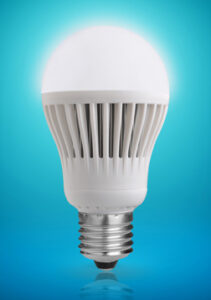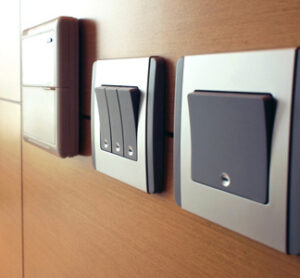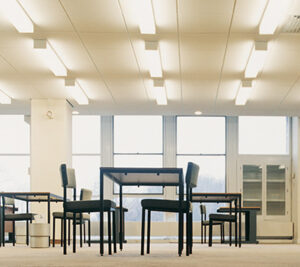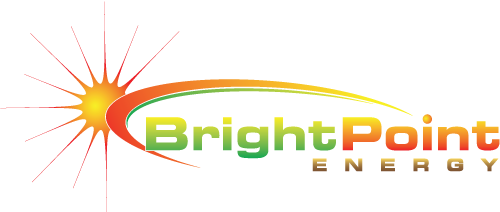LED Lighting Uses up to 90% less energy!
SAVE ENERGY. SAVE MONEY.
BrightPoint Energy has partnered with the top LED lighting manufacturers which allows us the opportunity to design, manufacture, and install custom lighting systems that maximize the energy efficiency for each customer. Just installing LEDs is not enough. You must choose the right solution. BrightPoint Energy is an expert at choosing the solutions that get our customers superb lighting performance, as well as energy efficiency, all while saving money.
 LED Lighting – More Light, Less Power
LED Lighting – More Light, Less Power
A typical fluorescent light, which is common in commercial buildings, lasts on average about 12-20,000 hours (at best). LEDs have a burn life of at least 75,000 hours!! At 12 hours per day, 5 days per week, that is over 26 years! Longer life and less maintenance means more money in your pocket and less time replacing light bulbs and ballasts.
Top 5 Reasons to Switch to LED Lighting
- Reduce energy costs 40-90% by producing more light with less power.
- Lower maintenance costs, LEDs last up to 50x longer than other light sources. Your maintenance crew will thank you!!
- Tube lights are HOT! Stop heating up things you need to only light up. LEDs generate very little heat.
- End the cycle of sending waves of tube lights to landfills. They are an environmental hazard!
- Because saving 75-90% on what your business spends on lighting is smart, economical, and better for the environment.
LIGHTING CONTROL SYSTEMS
Increase efficiency by up to 50%!
SAVE ENERGY. SAVE MONEY.
Lighting controls are a simple way to gain more efficiency and control of your lighting system. If implemented by professional lighting designers and consultants who are focused on energy efficiency, lighting controls can add as much as 50% additional efficiency to your system, saving you energy and money!
 Take Efficiency to The Next Level
Take Efficiency to The Next Level
Lighting controls are best implemented in the second phase of a full lighting system retrofit. Adding lighting controls to an existing system can sometimes work against your efficiency goals, depending upon use of the current system and its current lighting technologies. For example, fluorescent lighting requires a certain time-on/off period in order to prevent premature failure. Adding timers and occupancy sensors can be detrimental if not programmed with that in mind.
If you are considering an LED retrofit, it may be more cost effective to wait to install lighting control systems at least 24-36 months after the retrofit. Why? The additional cost of the control system may actually harm the internal rate of return and net present value of the project. In simple terms, coupled with the cost of the retrofit, the cost of the controls may exceed any additional energy savings gained by the controls. You should consult an energy efficiency professional before adding lighting controls—not just an electrician or lighting control salesperson.
Top 5 Reasons to Add Lighting Controls
- Reduce energy consumption by as much as 50%.
- Increase workplace comfort by setting the right light levels for each work space and each hour of the day.
- Improve productivity by promoting a more pleasing atmosphere.
- Extend the life of your lighting system. Since your lighting system will only be “on” when needed, your useful life gets extended considerably.
- Easy to add to any existing system and are easy to operate

A lighting control system is an intelligent network based lighting control solution that incorporates communication between various system inputs and outputs related to lighting control with the use of one or more central computing devices. Lighting control systems are widely used on both indoor and outdoor lighting of commercial, industrial, and residential spaces. Lighting control systems serve to provide the right amount of light where and when it is needed.
The major advantage of a lighting control system over stand-alone lighting controls or conventional manual switching is the ability to control individual lights or groups of lights from a single user interface device. This ability to control multiple light sources from a user device allows complex lighting scenes to be created. A room may have multiple scenes pre-set, each one created for different activities in the room. A major benefit of lighting control systems is reduced energy consumption. Longer lamp life is also gained when dimming and switching off lights when not in use. Wireless lighting control systems provide additional benefits including reduced installation costs and increased flexibility over where switches and sensors may be placed.
NEW LIGHTBULBS: WHAT’S THE DIFFERENCE?
Traditional incandescent bulbs use a lot of energy to produce light and are no longer manufactured.
- 90% of the energy is given off as heat
- That lost energy is money we are throwing away
Newer energy-saving lightbulbs provide the choices in colors and light levels you’ve come to expect. The new lights are also much more efficient — so they save you money.
ENERGY SAVINGS CONSULTING
BrightPoint Energy Efficiency Consultants are trained to identify the most efficient ways to improve energy use within commercial buildings. They work directly with your employees to identify needs, issues, problems, and opportunities to save energy and save money. They help you customize solutions to maximize energy efficiency and minimize risk.
 65-75% of your electric bill is related to lighting & HVAC
65-75% of your electric bill is related to lighting & HVAC
Energy efficiency is important to the bottom line of every company. In the United States, the average commercial building spends nearly 40% of its energy budget on lighting. Another 30-35% is spent on HVAC systems. If approached from a consultative manner like we offer at BrightPoint Energy—as opposed to just purchasing products and materials from distributors and electricians—commercial buildings are able to shave approximately 30% off of their energy budgets every year through the effective implementation of energy efficiency technologies.
Increase cash flow from day one.
Our services require no out-of-pocket capital expenses in most cases. 100% of our customers have increased cash flow from day one as a result of our energy efficiency consulting services.
Top 5 Reasons to use an Energy Efficiency Consultant:
- Our consultants are experts in energy efficiency. You know your business better than anyone, so why not hire someone who knows energy efficiency better than anyone?
- Our energy efficiency consultants know the pitfalls of technology fads, and can help navigate the confusing waters of energy technology, giving you peace of mind.
- We work in tandem with other technology experts to help consult on your project, helping you maximize your efficiency, and cost savings.
- BrightPoint Energy’s efficiency consultants are only interested in saving you money. Period. Their income comes from energy saved, not products sold. There is a BIG difference in hiring energy efficiency consultants versus hiring electrical contractors, or lighting distributors.
- We partner with you for the duration of your business’ lifetime. Since our expertise is in energy efficiency, and not just a specific product, we partner with you for years to come, to help you implement the best technologies available, saving you hundreds of thousands of dollars in energy costs.
Questions?
LIGHTING FAQS
Why wouldn’t I just do my own fixture and bulb replacements?
This is a reasonable question, and for some organizations you may be able to do this yourself. But most of our customers find that BrightPoint Energy turnkey services wind up being less than what it would cost to self perform. We handle all logistics, project management, finance origination, tax certification, procurement, warranty processing, and much more. With our efficient business model, manufacturer direct procurement, and national installer network, we’ve found that we are a convenient and reliable option.
Are LEDs cost effective?
Prices of LEDs have come down, while the technology has advanced considerably. LEDs are still more expensive than traditional lighting options as far as price goes, but LEDs cost much less to operate. With BrightPoint Energy analytics tools you can find out exactly how much you can increase your profits by switching to LEDs.
Are there ways to finance 100% of the price?
Yes, BrightPoint Energy offers more financing options than any other LED provider, we have a vast selection of financing options that are sure to fit your needs.
How long do LEDs last?
Unlike other light sources, LEDs usually don’t “burn out”; instead, they get progressively dimmer over time (a process called lumen depreciation). LED useful life is typically based on the number of operating hours until the LED is emitting 70 percent of its initial light output. Good-quality white LEDs in well-designed fixtures are expected to have a useful life of 75,000 hours or even longer, all the way up to 100,000 hours! A typical incandescent lamp lasts about 1,000 hours; a comparable CFL lasts 8,000 to 10,000 hours.
How long is 100,000 hours?
Based on how long a fixture is illuminated per day, here’s what 100,000 works out to:
Hours of Operation: 100,000 hours
11.4 years at 24 hours a day
15.22 years at 18 hours a day
22.8 years at 12 hours a day
34.2 years at 8 hours a day
Can I dim LEDs, and use them with control units like occupancy sensors?
Yes, you can dim LEDs.
Why the pricing differences on LED lighting?
There are a LOT of manufacturers for LEDs and the price ranges vary greatly. Most of the variance is attributed to the rating and warranty of the specific light. It is important that you check any products you’re considering purchasing with Design Lights Consortium (DLC) to verify they are properly rated and certified. Most all of the BrightPoint Energy products have 10 year warranties and are Energy Star rated, all of our products are DLC certified.
Do LEDs provide high quality lighting?
Color appearance is communicated using correlated color temperature (CCT) on the Kelvin (K) scale. For most interior lighting applications, warm-white (2700K to 3000K) and in some cases neutral-white (3500K to 4000K) light is appropriate. Cool-white LEDs with very high CCT (bluish in appearance) tend to offer higher efficacy at low cost, but may not meet user expectations for color. An increasing number of high-efficacy LED products are available in warm-white or neutral-white colors, to the point where many have surpassed CFLs. Two light sources with identical CCTs can render object colors very differently due to the differences in spectra. While CCT provides an indication of whether a light source may appear yellowish or bluish in color, Duv is an additional metric that can help identify sources with excessively greenish or pinkish hues.
Color rendering, or color rendering index (CRI) measures the ability of light sources to render colors, compared to either incandescent reference sources if warm in color, or daylight reference sources if cooler in color. The leading high-efficiency LED manufacturers now claim a CRI of 80 or higher for phosphor-converted, warm-white devices. In general, a minimum CRI of 80 is recommended for interior lighting, with CRIs of 90 or higher indicating excellent color rendering. The CRI has been found to be inaccurate for RGB (red, green, blue) LED systems because it’s poor at predicting the quality of the appearance of saturated color objects, and doesn’t correspond well to human perception of color quality. As a supplement to CRI, a lamp’s R9 value describes how closely it renders a saturated red color sample, relative to the reference illuminant. CCT and CRI together only get you in the ballpark for selecting and matching lamp colors. A number of new color-rendering metrics have been proposed in recent years, but none have been widely adopted as of yet. In the meantime, color rendering of LED products should be evaluated in person and in the intended application if possible.
Why would I do a complete lighting replacement instead of replacing as I go?
Our services require no out-of-pocket capital expenses in most cases. 100% of our customers have increased cash flow from day one as a result of our energy efficiency consulting services.
